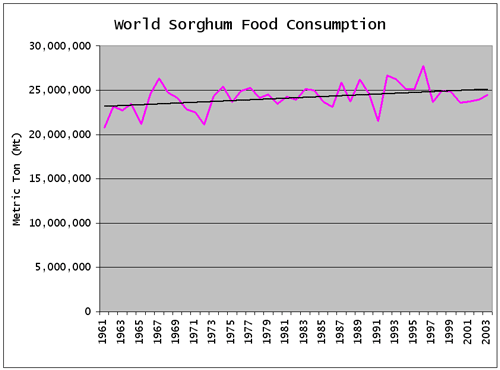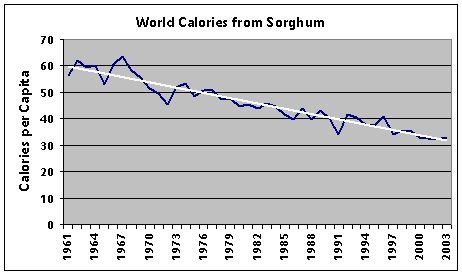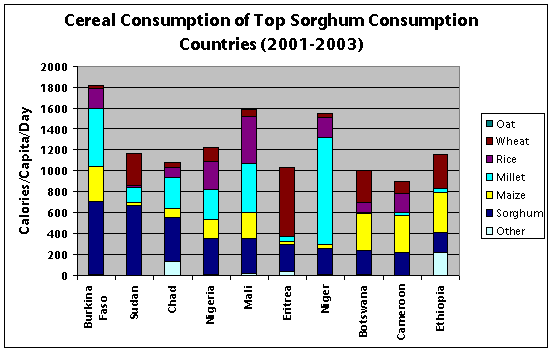![]() Species |
Rice |
Maize |
Wheat |
Barley |
Oats |
Foxtail Millet |
Pearl Millet |
Rye |
Sorghum |
Wild Rice |
Brachypodium |
Oryza Species |
Grape |
Arabidopsis
Species |
Rice |
Maize |
Wheat |
Barley |
Oats |
Foxtail Millet |
Pearl Millet |
Rye |
Sorghum |
Wild Rice |
Brachypodium |
Oryza Species |
Grape |
Arabidopsis
 |  |
By placing trend lines we can see (Figure 1) that global sorghum consumption as a human food (not including animal feeds) has increased since 1961, yet Figure 2 indicates that the average calorie intake from sorghum has been almost cut in half. At first these statistics may seem contradictory, but when we take into consideration the population growth of the world the explanation is found. Sorghum production and consumption are both up, but they are not growing as fast as the world population. Therefore, the supply (and calories) per capita is necessarily decreasing.
The top sorghum producers are #1 - US, and #2 - Nigeria tying with India. But the US is the top exporter (70% to 80% of world sorghum exports) (7), and coupled with the major US use of sorghum as livestock feed we can understand why the US ranks only 45th (out of 54) on consumption. India ranks 27th for consumption, possibly explained as being so low in comparison to production because of their tremendous population size in addition to their dependence upon rice.
Not surprisingly, most of the top consumers of grain sorghum also eat a lot of millet (see Figure 4.). Millet and sorghum are the grains most suited for growing in those environments. Sorghum is used in many foods, such as porridge, breads, baked goods, couscous, and alcoholic beverages (8). The most commons forms are boiled grains or ground flour (8).
You may notice that Figures 3 and 4 show the top consumers in a different order. This is due to the fact that Figure 3 is based on a four-year average, and Figure 4 is based on a three-year average. The top countries tend to remain the same, although they do vary their order from year to year.
 |
 |
Sorghum can be used as a gluten-free replacement for wheat, but due to the lack of gluten sorghum breads are generallly unleavened. Some varieties are rich in antioxidants. And except for the high-tannin sorghum, the flavor is neutral and the grain is known for taking on the flavors of the other ingredients (8).
References: